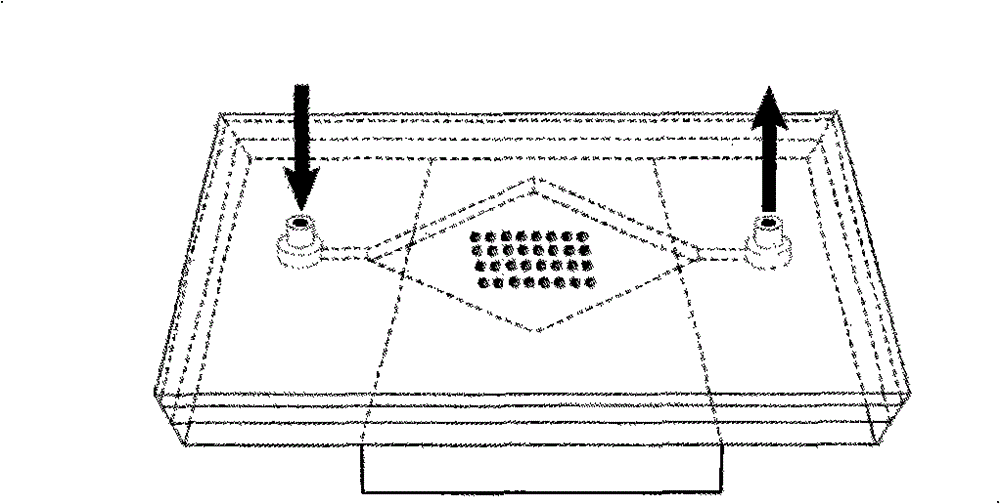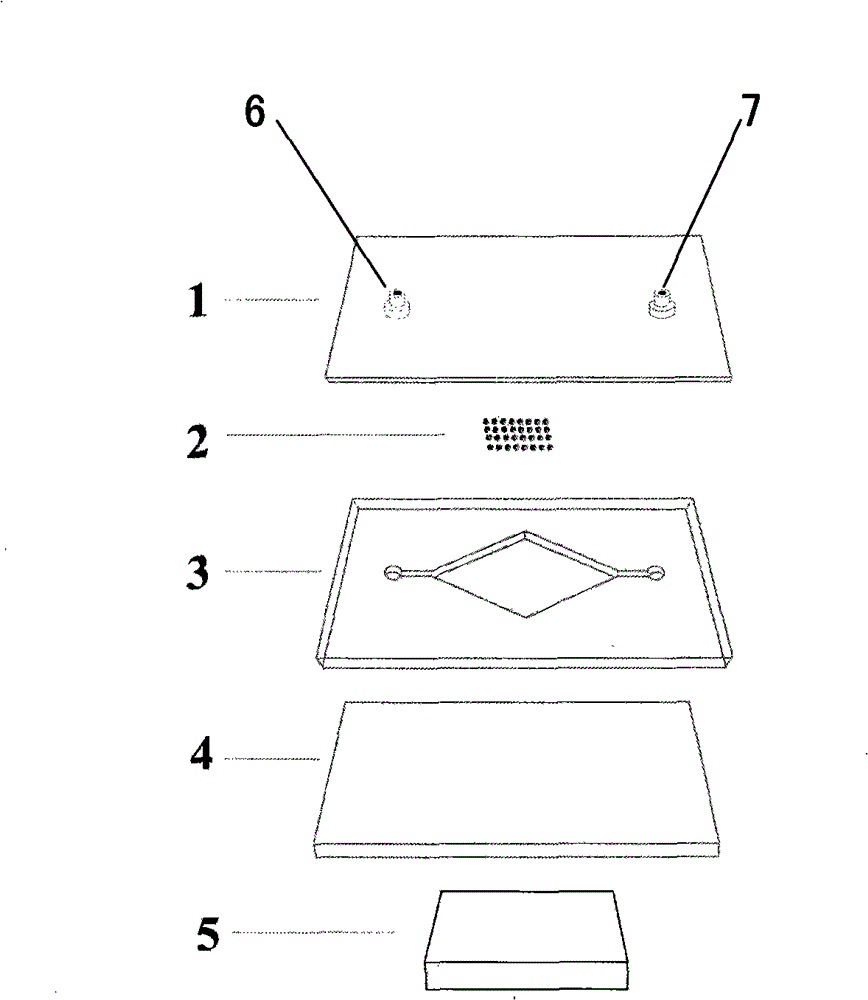Magnetic particle micro array apparatus for high throughput detecting biomacromolecule and its use method
A technology of biological macromolecules and magnetic particles, used in biological testing, analytical materials, material inspection products, etc., can solve the problems of complex operation of biochips, complex chemical modification of glass slides, complex fixing process, etc., to reduce experimental costs and detect The effect of fast and simplified preparation
- Summary
- Abstract
- Description
- Claims
- Application Information
AI Technical Summary
Problems solved by technology
Method used
Image
Examples
Embodiment 1
[0016] A magnetic particle microarray device for detecting high-throughput biomacromolecules, including a microfluidic reaction cell cover sheet 1, a microarray composed of a sample to be detected-biomacromolecule-magnetic particle complex 2, polydimethylsiloxane Microfluidic reaction pool 3, slide glass 4 and magnet 5, described microfluidic reaction pool cover sheet 1 is provided with buffer solution inlet 6 and buffer solution outlet 7, and microfluidic reaction pool cover sheet 1 is arranged on polydimethylsiloxane Above the oxane microfluidic reaction pool 3, the buffer inlet 6 and the buffer outlet 7 communicate with the polydimethylsiloxane microfluidic reaction pool 3, and the microarray composed of the sample to be detected-biological macromolecule-magnetic particle complex 2 is set in the polydimethylsiloxane microfluidic reaction pool 3 , the glass slide 4 is set under the polydimethylsiloxane microfluidic reaction pool 3 , and the magnet 5 is set under the glass sli...
Embodiment 2
[0018] A method for using a magnetic particle microarray device for detecting high-throughput biomacromolecules. A sample to be detected is added to magnetic particles immobilized with biomacromolecules, and the molecules to be detected are combined with biomacromolecules connected to the surface of the magnetic particles. Get the sample-biological macromolecule-magnetic particle complex on the surface of the magnetic particle; put the sample-biological macromolecule-magnetic particle complex through the spotting device, and spot the sample into the polydimethylsiloxane microfluidic reaction cell , forming a microarray composed of the sample to be detected-biological macromolecule-magnetic particle complex, the microarray is magnetically fixed by the magnet; after the polydimethylsiloxane microfluidic reaction cell is sealed by the microfluidic reaction cell cover, Add fluorescently labeled probes or fluorescently labeled antibodies to the dimethylsiloxane microfluidic reaction...
Embodiment 3
[0020] Preparation of Magnetic Particle Microarray:
[0021] Schematic diagram of magnetic particle microarray attached figure 1 As shown, including slide glass, permanent magnet, polydimethylsiloxane (PDMS) microfluidic reaction cell (for the preparation method, see: Pantoja et al, Biosensors and Bioelectronics, 2004, vol 20, 3, 509-517), The magnetic particle and the cover sheet of the microfluidic reaction pool are composed of five parts. Wherein, a magnet is used to adhere to the back side of the sample area of the glass slide, and the magnetic particles are sampled in a microfluidic reaction cell prepared by PDMS. There are buffer inlets and outlets on the microfluidic coverslip, allowing various buffers and reaction solutions to flow into and out of the microfluidic reaction pool.
[0022] SNP Typing Using Magnetic Particle Microarrays
[0023] 1. In this example, we take the detection of the MTHFR gene (methylenetetrahydrofolate reductase gene) C677T SNP site as an...
PUM
 Login to View More
Login to View More Abstract
Description
Claims
Application Information
 Login to View More
Login to View More - R&D
- Intellectual Property
- Life Sciences
- Materials
- Tech Scout
- Unparalleled Data Quality
- Higher Quality Content
- 60% Fewer Hallucinations
Browse by: Latest US Patents, China's latest patents, Technical Efficacy Thesaurus, Application Domain, Technology Topic, Popular Technical Reports.
© 2025 PatSnap. All rights reserved.Legal|Privacy policy|Modern Slavery Act Transparency Statement|Sitemap|About US| Contact US: help@patsnap.com


